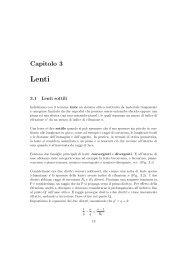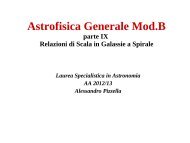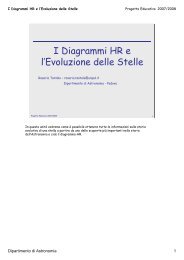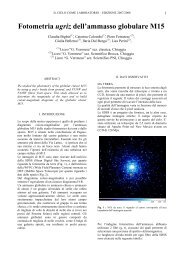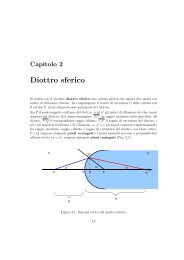curriculum vit atque scientifico-professionale - Dipartimento di Fisica ...
curriculum vit atque scientifico-professionale - Dipartimento di Fisica ...
curriculum vit atque scientifico-professionale - Dipartimento di Fisica ...
Create successful ePaper yourself
Turn your PDF publications into a flip-book with our unique Google optimized e-Paper software.
CURRICULUM VITÆ of ROSARIA TANTALO<br />
Address<br />
Department of Astronomy - Vicolo Osservatorio 3 -<br />
University of Padova -35122 Padova - Italy<br />
Phon: +39-049-8278253 (office)<br />
Fax: +39-049-8278212<br />
E-mail: rosaria.tantalo@unipd.it<br />
Personal Data<br />
Born in Matera, Italy, July 10, 1966<br />
Married with Francesco Macino on June 22, 1996.<br />
EDUCATION<br />
July 1984: Diploma <strong>di</strong> maturità: “Tecnico <strong>di</strong> Laboratorio Chimico e Biologico”<br />
July 25, 1994: Laurea in Astronomy, at the University of Padova (Italy)<br />
Thesis title: ``Spectro-Photomery of Elliptical Galaxies: Models with Infall``.<br />
Supervisors Prof. Cesare Chiosi, Prof. Alessandro Bressan, and Dr. Franco Fagotto)<br />
May 13, 1998: Dottorato <strong>di</strong> Ricerca in Astronomy at the University of Padova (Italy)<br />
Thesis title: ``GALAXY FORMATION AND EVOLUTION: Spectro- photometric Models of<br />
Elliptical Galaxies``.<br />
Supervisor Prof. Cesare Chiosi<br />
Fellowships<br />
1. Post-Doc fellowship of 2 years at the Padova University from March the 1 st 1999 to March the 1 st , 2001;<br />
2. Assegno <strong>di</strong> Ricerca for the research project: Age of Elliptical Galaxies at the University of Padova from 1 st of<br />
April 2002 to March 31, 2004;<br />
3. Assegno <strong>di</strong> Ricerca for the research project: Stars with low metallicity in Early-Type Galaxies at the<br />
University of Padova from 1 st of April, 2004 to December 31, 2004;<br />
Research Experience<br />
Evolution of stellar population, chemical evolution and photometry of galaxies.<br />
Theaching Acti<strong>vit</strong>ies<br />
• April 2004: “Theory of the Mixing Length” (6 hours) during the course of “Astrofisica II” c/o the department<br />
of Astronomy of the Padova University (Prof. Cesare Chiosi)<br />
• May 2005: “Theory of the Mixing Length” (5 hours) during the course of “Astrofisica II” c/o the department<br />
of Astronomy of the Padova University (Prof. Cesare Chiosi)<br />
1
STAGES BY FOREIGN INSTITUTES<br />
1. From January 12 to February 8, 1997 c/o MSSSO in Camberra, Australia, to work with Dr. Brad Gibson.<br />
During this period I have given a seminar on: Is the stronger Mg2 index an in<strong>di</strong>cator of [Mg/Fe]<br />
enhancement?<br />
2. From May 24 to June 12, 2004 c/o I.A.C. (Istituto de Astrofisica de Canarias) in Tenerife (Spain), to work<br />
with Dr. Alexandre Vazdekis. During this period I have given a seminar on: Absorption-line in<strong>di</strong>ces from<br />
high-resolution spectra<br />
Languages<br />
(1) English: good (rea<strong>di</strong>ng, writing, speaking)<br />
(2) Spanish: good (rea<strong>di</strong>ng, writing, speaking)<br />
Informatics<br />
LANGUAGES AND INFORMATICS KNOWLEDGES<br />
(1) FORTRAN (very good)<br />
(2) Operation Systems: UNIX, WINDOWS, LinuX (good)<br />
(3) Object Languages: JAVA (me<strong>di</strong>um)<br />
ACTUAL POSITION<br />
Technical-scientific position for outreach acti<strong>vit</strong>y and data elaboration at the University of Padova, in the field of<br />
the Educational Project “Il Cielo come Laboratorio” which include some lessons for high schools students.<br />
NATIONAL AND INTERNATIONAL SCHOOL<br />
1. Student of European Astrophysics Doctoral Network Predoctoral School VIII: Structure of the Universe.<br />
Leiden, Netherland, July 13-22, 1995<br />
2. National School of Astrophysics, I cycle (1995-1996), III course: AGN-Ogetti Collassati-Evoluzione Stellare.<br />
Giulianova Lido, Italy, May 5-11, 1996<br />
3. VIII Canary Islands Winter School: Stellar Astrophysics for the Local Group: A first step to the Universe.<br />
Tenerife, Canary Islands (Spain), December 2-13, 1996<br />
4. National School of Astrophysics, II cycle (1996-1997), I course: Galassie - <strong>Fisica</strong> Solare e Stellare. Acireale,<br />
Italy, May 25-30, 1997<br />
2
5. XI Canary Islands Winter School: Galaxies at High Redshift. Santa Cruz de Tenerife, Tenerife, Canary Islands<br />
(Spain), November 15-26, 1999<br />
6. National School of Astrophysics, V cycle (1999-2000), IV course: Galaxies Formation - Active Galactic<br />
Nuclei. Asiago, Italy, September 10-16, 2000<br />
7. National School of Astrophysics, VI cycle (2000-2001), II course: Chemical Evolution of Galaxies - High<br />
Resolution Spectroscopy. Trieste, Italy, October 15-19, 2001<br />
8. XIII Canary Islands Winter School: COSMOCHEMISTRY. The Melting Pot of elements. Puerto de la Cruz,<br />
Tenerife, Canary Islands (Spain), November 19-30, 2001<br />
MEETINGS AND CONFERENCES<br />
1. PASP Conference: From Stars to Galaxies: The impact of Stellar Physics on Galaxy Evolution. Crete, Greece,<br />
October 9-13, 1995<br />
2. The IAU Symposium 189: Fundamental Stellar Properties: The Interaction between Observation and Theory.<br />
Sydney, Australia, January 12-17, 1997<br />
3. TMR Workshop: Semi-analytical models of Galaxy Formation. MPA in Munich, Germany, March 21-22,<br />
1997<br />
4. 1997 TMR Annual Meeting: Galaxy Formation and Evolution. Ringberg, Germany, May 19-24, 1997<br />
5. 38 th Herstmonceux Conference: The Stellar Initial Mass Function. Cambridge, UK, July 14-18, 1997<br />
6. DM-ITALIA-97, Dark-matter: Prospettive e Progetti. Trieste, Italy, December 9-11, 1997.<br />
7. Evolving Evolution: Evoluzione stellare in Italia, lo stato dell'Arte. CarloForte, Isola <strong>di</strong> San Pietro, Italy, June<br />
8-11, 1998.<br />
8. Euroconference on The Evolution of Galaxies on Cosmological Timescales. Puerto de la Cruz, Tenerife, Spain,<br />
November 30 – December 5, 1998.<br />
9. 1 st Workshop del Network Italiano on Formazione ed Evoluzione delle Galassie. Padova, Italy, May 18-19,<br />
1999<br />
10. Guillermo Haro Workshop 99: Large Scale Structure & Clusters of Galaxies. Tonantzintla, Puebla, Mexico,<br />
From June 14 to July 30, 1999<br />
11. 2 nd Mini-Workshop on Sintesi <strong>di</strong> popolazione (Italian Network on: Formazione ed Evoluzione delle Galassie)<br />
Padova, Italy, December 3, 1999<br />
12. International Workshop on: Tracing Cosmic Evolution with Galaxy Clusters. Sesto Pusteria, Bolzano, Italy,<br />
July 3-6, 2001<br />
13. GAIA Workshop: Ra<strong>di</strong>al Velocity Spectrometer Workshop n.2. Asiago, Vicenza, Italy, February 7-9, 2002<br />
14. XLVI Congresso Nazionale della SAIt. Padova, Italy, April 10-12, 2002<br />
3
15. International Conference on: New Horizons in Globular Cluster Astronomy. Padova, Italy, June 24-28, 2002<br />
16. Ringberg Workshop on: The Chemical Evolution of Dwarf Galaxies - Present Status and Perspectives.<br />
Ringberg Castle, Bavaria, Germany, July 29 – August 2, 2002<br />
17. Monte Rosa International Conference: GAIA Spectroscopy, Science and Technology. Gressoney St. Jean<br />
(Aosta), Italy, September 9-12, 2002<br />
18. GAIA Workshop: Ra<strong>di</strong>al Velocity Spectrometer Workshop IV. Gressoney St. Jean (Aosta), Italy, September<br />
13, 2002<br />
19. Cosmo 2002: VII Congresso Nazionale <strong>di</strong> Cosmologia. Monte Porzio Catone (Roma), Italy, November 5-8,<br />
2002<br />
20. Stars in Galaxies: IV Workshop Nazionale su Stellar Astrophysics. Santa Cruz de La Palma, Spain, March 7-<br />
11, 2003<br />
21. International Conference: Stellar Populations 2003. Garching, Germany, October 6-10, 2003<br />
22. International Conference: IMF@50: The inital mass function 50 years later. Abbazia <strong>di</strong> Spineto, Siena, Italy,<br />
May 16-20, 2004<br />
23. International Workshop: The Spectral Energy Distribution of Gas Rich Galaxies: Confronting Models with<br />
Data. Heidelberg, Germany, October 4-8, 2004<br />
24. International Workshop: Stellar Pulsation and Evolution. Monte Porzio Catone, Roma, Italy, June 19-24,<br />
2005<br />
25. EARA Workshop 2006: Galactic Bulges. Padova, Italy, January 25-26, 2006<br />
26. International Conference: From Stars to Galaxies: buil<strong>di</strong>ng the piece sto build up the Universe. Venice, Italy,<br />
October 16-20, 2006<br />
27. The IAU Symposium 241: Stellar Population as buil<strong>di</strong>ng blocks of Galaxies. St. Cruz de La Palma, Canary<br />
Islands, Spain, December 10-16, 2006<br />
Journals with Referee<br />
PUBLICATION LIST<br />
1. Spectro-photometric Evolution of Elliptical Galaxies. II. Models with Infall. R. Tantalo, A. Bressan, C. Chiosi,<br />
F. Fagotto, 1996. A&A, 311, 361.<br />
2. Probing the Age of Elliptical Galaxies. A. Bressan, C. Chiosi, R. Tantalo, 1996. A&A, 311, 425. (astroph9602032)<br />
3. Ages and Metallicities in Elliptical Galaxies from the Hβ, 〈Fe〉, and Mg2 Diagnostics. R. Tantalo, C. Chiosi, A.<br />
Bressan, 1998b. A&A, 333, 419.<br />
4
4. Spectro-photometric Evolution of Elliptical Galaxies. III. Infall models with gra<strong>di</strong>ents in mass density and star<br />
formation. R. Tantalo, C. Chiosi, A. Bressan, L. Portinari, P. Marigo, 1998a. A&A, 335, 823. (astroph/9710079)<br />
5. A new scenario of galaxy evolution under a universal Initial Mass Function. C. Chiosi, A. Bressan, L.<br />
Portinari, R. Tantalo 1998. A&A, 339, 335.<br />
6. Enhancement of a-elements in Dinamical Models of Elliptical Galaxies. R. Tantalo, C. Chiosi, 2002. A&A,<br />
388, 396.<br />
7. Shells of dust around AGB stars: effects on the integrated spectrum of single stellar populations. L. Piovan, R.<br />
Tantalo, C. Chiosi, 2003. A&A, 408, 559.<br />
8. On the Mass-to-Light ratio and the Initial Mass Function in galactic <strong>di</strong>scs. L. Portinari, J. Sommer-Larsen, R.<br />
Tantalo, 2004. MNRAS, 347, 691.<br />
9. Star Formation History of Early Type Galaxies. I. The line absorption In<strong>di</strong>ces <strong>di</strong>agnostics. R. Tantalo, C.<br />
Chiosi, 2004. MNRAS, 353, 405.<br />
10. Measuring age, metallicity and abundance ratios from absorption line in<strong>di</strong>ces. R. Tantalo, C. Chiosi, 2004.<br />
MNRAS, 353, 917.<br />
11. Modelling galaxy spectra in presence of interstellar dust. I. The model of ISM and the library of dusty SSPs.<br />
L. Piovan, R. Tantalo, C. Chiosi, 2006, MNRAS, 366, 923.<br />
12. Modelling galaxy spectra in presence of interstellar dust. II. From the UV to the far infrared. L. Piovan, R.<br />
Tantalo, C. Chiosi, 2006, MNRAS, 370, 1454.<br />
13. New response functions for absorption-line in<strong>di</strong>ces from high-resolution spectra. R. Tantalo, C. Chiosi, L.<br />
Piovan, 2007, A&A, 462, 481.<br />
14. The Galaxy Evolution Explorer UV emission in shell galaxies: tracing galaxy `rejuvenation' episode. R.<br />
Rampazzo, A. Marino, R. Tantalo, D. Bettoni, L.M. Buson, C. Chiosi, G. Galletta,, R. Grützbauch, R.M. Rich,<br />
2007, MNRAS, 381, 245<br />
15. XMM-Newton X-ray and Optical Monitor far UV observations of NGC 7070A and ESO 2400100 shell<br />
galaxies. G. Trinchieri, R. Rampazzo, C. Chiosi, R. Grützbauch, A. Marino, R. Tantalo, 2008, in press<br />
Conference Procee<strong>di</strong>ngs<br />
1. Integrated Infrared Colors of Star Cluster in the Galaxy and M 31. A. Vallenari, C. Chiosi, R. Tantalo, 1996.<br />
ESO Astrophysics Symposia 1996, p.113. D. Minniti (eds.)<br />
2. Spectro-photometric Models of Elliptical Galaxies with Infall. R. Tantalo, C. Chiosi, A. Bressan, F. Fagotto,<br />
1996. ASP Conference Series, Vol. 98, p.42. C. Leitherer, U.-Fritze Von Alvensleben and J. Huchra (eds.)<br />
3. Elliptical Galaxies: The Age Metallicity Dilemma. A. Bressan, C. Chiosi, R. Tantalo, 1996. ASP Conference<br />
Series, Vol. 98, p.49. C.Leitherer, U.-Fritze Von Alvensleben and J. Huchra (eds.)<br />
4. A DATA BASE FOR GALAXY EVOLUTION MODELLING. C. Leitherer et al. 1996. PASP, Vol. 108, p.996.<br />
5. Models of Elliptical Galaxies: the Gra<strong>di</strong>ents. R. Tantalo, C. Chiosi, A. Bressan, 1997. ESO Workshop held<br />
November 1996, p.396. L.N. da Costa and A. Renzini (eds.)<br />
5
6. Is the stronger Mg2 index an in<strong>di</strong>cator of [Mg/Fe] enhancement? R. Tantalo 1998. IAU Symposium 189,<br />
p.104. T.R. Bed<strong>di</strong>ng, A.J. Booth and J. Davis (eds.)<br />
7. The Problem of α-elements Enhancement in Elliptical Galaxies. R. Tantalo, 1999. Procee<strong>di</strong>ngs of the 1 st<br />
Workshop of the Italian Network on: “Formation and Evolution of Galaxies”, p.141. C. Chiosi, L. Portinari<br />
and R. Tantalo (eds.)<br />
8. Properties of Elliptical Galaxies from Spectral In<strong>di</strong>ces. R. Tantalo, 1999. Procee<strong>di</strong>ngs of the 2 nd Workshop of<br />
the Italian Network on: “Formation and Evolution of Galaxies - Stellar Population Synthesis”, p.1. B.M.<br />
Poggianti (eds.)<br />
9. Ages, Metallicities and Abundances in Elliptical Galaxies. R. Tantalo, 2001. Ap&SS, Vol. 276, p.1189, J.<br />
Dyson and S.A. Lamb (eds.)<br />
10. In<strong>di</strong>ces for SSPs with enhanced mix of α-elements. R. Tantalo, 2002. PASP Conference Series, Vol. 268,<br />
p.445. S. Borgani, M. Mezzetti and R. Valdarnini (eds.)<br />
11. Line in<strong>di</strong>ces as age, metallicity and abundance ratio in<strong>di</strong>cators. R. Tantalo, C. Chiosi, 2003. Mem. SAIt.,<br />
Vol. 74, p.518<br />
12. Line in<strong>di</strong>ces as age, metallicity and abundance ratio in<strong>di</strong>cators. R. Tantalo, C. Chiosi, 2003. APS Conference<br />
Series, Vol. 298, p.477, U. Munari (eds.)<br />
13. The Mass to Light ratio and the Initial Mass Function in galactic <strong>di</strong>scs. L. Portinari, J. Sommer-Larsen, R.<br />
Tantalo, 2003. Ap&SS, Vol. 284, p.723. G. Hensler et al. (eds.)<br />
14. Measuring age, metallicity and abundance ratios from absorption line in<strong>di</strong>ces. R. Tantalo, 2004. Mem. SAIt.,<br />
Vol. 75, p.202<br />
15. Mass to Light ratio,Initial Mass Function and chemical evolution in <strong>di</strong>sc galaxies. L. Portinari, J. Sommer-<br />
Larsen, R. Tantalo, 2004. PASA, Vol. 21, p.144. B.K. Gibson and D. Kawata (eds.)<br />
16. The stellar Mass-to-Light ratio in <strong>di</strong>sc galaxies. L. Portinari, J. Sommer-Larsen, R. Tantalo, 2004. IAU<br />
Symposium 220, p.309<br />
17. New database of SSPs with <strong>di</strong>fferent IMFs. R. Tantalo, 2005. ASSL (Astrophysics and Space Science<br />
Library), Vol. 327, p.235, E. Cobelli, F. Palla and H. Zinnecher (eds.)<br />
18. Synthetic Galactic Spectra in presence of dust: from the UV to the far-IR. L. Piovan, R. Tantalo, C. Chiosi,<br />
2005. AIP Conference Series, Vol. 716, p.91, C.C. Popescu and R.J. Tuff (eds.)<br />
19. Spectral energy <strong>di</strong>stribution in presence of shells of dust around AGB stars. L. Piovan, R. Tantalo, C. Chiosi,<br />
2006. Mem. SAIt. Vol. 77, p.873<br />
20. Insight about induced SFR in the shell system of early-type galaxies from UV observations. L. Buson, D.<br />
Bettoni, R. Rampazzo, A. Marino, G. Galletta, C. Chiosi, R. Tantalo, R.M. Rich, 2007. IAU Symposium,<br />
Vol.235, p.305. F. Combes and J. Palous (eds.)<br />
21. New response functions for absorption-line in<strong>di</strong>ces from high-resolution spectra. R. Tantalo, C. Chiosi, L.<br />
Piovan, 2007, IAU Symposium 241, p.143. A. Vazdekis and R.F. Peletier (eds.)<br />
22. Effects of Dust on Galactic Spectral Energy Distributions. L. Piovan, R. Tantalo, C. Chiosi, 2007, ASP<br />
Conference Series, Vol.374, p.355. A. Vallenari, R. Tantalo, L. Portinari and A. Moretti (eds.)<br />
23. New Response Functions for Absorption-Line In<strong>di</strong>ces from High-Resolution Spectra. R. Tantalo, C. Chiosi, L.<br />
Piovan, 2007, ASP Conference Series, Vol.374, p.373. A. Vallenari, R. Tantalo, L. Portinari and A. Moretti<br />
6
(eds.)<br />
24. Photometric Properties of Early-Type Galaxies from Simulations. S. Chinellato, R. Tantalo, C. Chiosi, 2007,<br />
ASP Conference Series, Vol.374, p.493. A. Vallenari, R. Tantalo, L. Portinari and A. Moretti (eds.)<br />
25. Tracing Galaxy Evolution in the Field: the UV Emission in shell galaxies mapped by GALEX. D. Bettoni, A.<br />
Marino, L. Buson, C. Chiosi, G. Galletta, R. Ramazzo, R. Tantalo, M. Rich, 2008, Mapping the Galaxy and<br />
Nearby Galaxies, p.311, K. Wada and F. Combes (eds.)<br />
26. The GALEX UV emission in shell galaxies. A. Marino, R. Rampazzo, R. Tantalo, D. Bettoni, L.M. Buson, C.<br />
Chiosi, G. Galletta, 2008, ASP Conference Series, in press<br />
Accepted paper not published<br />
1. To what extent are Mg2 and 〈Fe〉 in<strong>di</strong>cators of Mg and Fe abundances? . R. Tantalo, A. Bressan, C. Chiosi,<br />
1997. Submitted to A&A and accepted (astro-ph/9710101)<br />
2. Diagnostic of chemical abundances and ages from the line strength in<strong>di</strong>ces Hβ, 〈Fe〉 and Mg2: what do they<br />
really imply? R. Tantalo, A. Bressan, C. Chiosi, 1997. Submitted to A&A (astro-ph/9705060)<br />
CURRENT RESEARCH INTERESTS<br />
1. Scientific rationale and summary of my past and present research interests<br />
The main issue with elliptical galaxies (EGs) concerns their formation and evolution. Are the EGs formed via<br />
mergers of sub-structures composed by gas and stars? Is every event followed by stellar acti<strong>vit</strong>y? Or, otherwise,<br />
are the EGs formed in early epochs from a initial mass of gas transformed in stars without subsequent star<br />
formation (SF)? Related to this general topic, there are several problems which I have been working on during<br />
the past few years. They are shortly presented. In the section below I will describe in some detail my own<br />
contribution to each of them.<br />
(1) Colour-Magnitude Relation (CMR)<br />
Brighter EGs seem to be also redder. The CMR for EGs in galaxy clusters is tight and this means that these<br />
objects are old (say 12--13 Gyr) and coeval (Bower et al. 1992). The CMR for the field and group galaxies is<br />
more <strong>di</strong>sperse and seems to suggest prolonged history of star formation (Schweitzer & Seitzer 1992).<br />
(2) The SGWM<br />
Along the CMR for EGs the metallicity increases with their luminosity (mass). Larson (1974) has suggested<br />
the Supernovae Galactic Wind Model (SGWM) to explain the higher metallicity associated to brighter<br />
galaxies (longer SF).<br />
(3) α−Elements<br />
The gra<strong>di</strong>ents of Mg2, 〈Fe〉 and other in<strong>di</strong>ces seems to reflect gra<strong>di</strong>ents in the chemical abundance ratios<br />
[α/Fe] (Matteucci 1997). The ratio tends to increase with the galactic luminosity suggesting that the duration<br />
of the SF acti<strong>vit</strong>y decreases at increasing mass: ΔtSF ∝ MG −1 , the opposite of what is required by the SGWM.<br />
(4) UV-Excess<br />
Another important property of the EGs is the so-called ultraviolet-excess (UV-excess). Observations in the<br />
UV band have shown that these, apparently old, objects emit a significant fraction of their luminosity in the<br />
far-UV (spectral region shortward of 2,000 Å). While the UV-flux seems to change among EGs, the infrared<br />
flux is nearly the same for all of them. This behaviour suggests the presence of a hot stellar component in the<br />
stellar of EGs. The UV-excess is currently measured by the (1550−V) colour. It is correlated with the<br />
7
luminosity, velocity <strong>di</strong>spersion σ (mass in turn) and Mg2. As Mg2 is considered a metallicity in<strong>di</strong>cator,<br />
Burstein et al. (1988) argued that the UV-excess increases with the galaxy metallicity.<br />
(5) Age and metallicity<br />
The simultaneously analysis of some in<strong>di</strong>ces (such Hβ, Mg2, [MgFe], 〈Fe〉, etc.), the colour (1550-V), and the<br />
velocity <strong>di</strong>spersion σ, have shown that:<br />
a. Most of EGs cover the range of metallicity Z < Z < 3Z (Bressan, Chiosi, Tantalo 1996, Greggio 1996);<br />
b. Contrary to the straight conclusions that the scatter in Hβ implies a large age <strong>di</strong>spersion (Gonzàlez 1993,<br />
Worthey et al. 1994, Trager et al. 2000), it seems that all ellipticals are old but characterised by <strong>di</strong>fferent<br />
SF histories.<br />
Indeed, for some of them the SF is short and occurs at the beginning of their evolution, whereas for others it<br />
can be longer. It has been shown that the duration of the SF acti<strong>vit</strong>y see to decrease with velocity <strong>di</strong>spersion σ,<br />
i.e. the galaxy mass (Bressan, Chiosi, Tantalo 1996; Tantalo et al. 1998a).<br />
(6) Isolated and interacting EGs<br />
In the Hβ versus [MgFe] plane, pair- and shell-galaxies (interacting galaxies) and normal- and isolated<br />
galaxies shown the same <strong>di</strong>stribution (Longhetti et al. 1999, 2000). Does the secondary episode of SF not<br />
depend from interaction?<br />
(7) Galaxies captures<br />
An episode of SF in an EG involving only 5-10% of the total mass and occurred 5-6 Gyr ago implies bluer<br />
(B−V) colour with a spread of approximately 0.95 ± 0.05 (Chiosi 2000). This means that mergers followed by<br />
SF acti<strong>vit</strong>y are unlikely unless the SF has been very low. If the hierarchical scenario is at work for the<br />
formation of massive galaxies, then mergers must be occurred very early on (approximately half of the Hubble<br />
time).<br />
(8) Initial mass function (IMF)<br />
One of the fundamental parameters driving the chemical evolution of the galaxies is the IMF. Given the mass<br />
<strong>di</strong>stribution of stars in a single stellar population, the ratio of low- to high mass stars affects the chemical<br />
enrichment of the population. Over the years, <strong>di</strong>fferent stu<strong>di</strong>es on the IMF have shown that the number of lowmass<br />
stars is lower pre<strong>di</strong>cted by the Salpeter power-law. Padoan et al. (1997, 2000), Chiosi et al. (1998),<br />
Larson (1998) and Chabrier (2003), have proposed lognormal IMF, whose shape a peak mass changes with on<br />
the physical con<strong>di</strong>tions at which stars are formed. Systematic changes with the galaxy type and redshift of<br />
galaxy formation are also expected.<br />
(9) The effects of dust on integrated spectra of galaxies<br />
The advent of modern infrared astronomy has brought into evidence the role played by the<br />
interstellar dust in the subject of galaxy formation and evolution. Among other effects, dust absorbs<br />
the UV-optical light emitted by stars and return it into the far-infrared (far-IR). Therefore, to fully<br />
exploit modern data, models of galactic population synthesis must include this important component.<br />
Owing to the presence of interstellar dust, precious information on the star formation history (SFH)<br />
of galaxies, that in principle is derived from the UV/optical region of the spectrum are in reality<br />
hidden IR spectral region so that new tools suited to this kind of analysis have to be found.<br />
(10) High-resolution spectra<br />
Recently, high-resolution spectra for large samples of stars and galaxies have become available. To analyse<br />
these new data it is necessary to improve the population synthesis models inclu<strong>di</strong>ng new spectral libraries<br />
(theoretical and/or empirical) calculated with high-resolution. This would give us models of stellar<br />
populations and/or galaxies that can be <strong>di</strong>rectly compared with the new generation of data. In ad<strong>di</strong>tion to this,<br />
in order to fully explore the data, we have to generate libraries of stellar populations in which the effects of<br />
enhancement in α-elements are taken into account.<br />
8
2. Results obtained in the above items<br />
Chemical and photometric evolution of model galaxies<br />
The main tool I have adopted and partly developed during the past years is the chemical and spectrophotometric<br />
evolutionary model for elliptical galaxies (Bressan et al. 1994, Tantalo 1996, Tantalo et al. 1998).<br />
Applying this models, I have investigated a number of properties of EGs such as the CMR, the UV-excess, the<br />
broad-band colours etc. Key parameters of the model are the SFR, the accretion rate (infall), the IMF, the stellar<br />
nucleosynthesis yields (taken from Portinari et al. 1998 and Marigo 2002), the energy input from supernova<br />
explosion and stellar winds, the efficiency of galactic wind, the potential well of dark matter. The model pre<strong>di</strong>cts<br />
<strong>di</strong>fferent degree of chemical enrichment passing from massive to dwarf EGs. In this context I have examined in<br />
great detail the supernova driven galactic wind model by Larson (1974), the analogue of the G-Dwarf problems,<br />
the effects of infall on chemical enrichment, and the nature of the UV-excess (Tantalo 1994,1996 and Tantalo et<br />
al. 1996,1998). In ad<strong>di</strong>tion to this, I have combined the SFH resulting from the dynamical models of Chiosi &<br />
Carraro (2002) with a detailed chemical description in order estimate and test of the correspon<strong>di</strong>ng chemical<br />
enrichment history (Tantalo & Chiosi 2002).The result obtained for a dwarf and a normal EG have shown that<br />
massive galaxies have higher degree of enhancement which is explained by their short duration of star formation,<br />
whereas dwarf galaxies, with their prolonged stellar acti<strong>vit</strong>y in the burst mode have a lower degree of<br />
enhancement (Tantalo & Chiosi 2002). Furthermore I have suggested that the observed <strong>di</strong>spersion in the Mg2-σ<br />
plane is essentially due to the metallicity-σ-mass relation rather than <strong>di</strong>spersion in age and/or enhancement in αelements<br />
(Tantalo & Chiosi 2002).<br />
The UV-excess<br />
Several <strong>di</strong>fferent hypotheses have been proposed to interpret this emission. The first one suggested by Lee<br />
(1994) and Lee & Park (1997) assumes as can<strong>di</strong>dates for the UV-excess the old and metal-poor stars; the second<br />
one proposed by <strong>di</strong>fferent groups (Bressan et al. 1994, Dorman et al. 1995, Yi et al. 1998) suggests as can<strong>di</strong>dates<br />
the old, metal-rich stars. The two scenarios pre<strong>di</strong>ct <strong>di</strong>fferent ages for the onset of the UV flux in nearby galaxies:<br />
in the first case, EGs should be 3 Gyr older than typical globular clusters, whereas with the second scenario age is<br />
normal (say 12-13 Gyr) but another mechanism is at work. Greggio & Renzini (1990) examined all plausible<br />
can<strong>di</strong>dates for the UV-excess. In particular they suggest that it can be due to the combination of four kind of<br />
objects: (i) Post-AGB stars (stars that leave the AGB phase after the thermal pulsing phase, the so-called<br />
Planetary Nebulae) that are considered as the “classical” sources; (ii) very hot horizontal branch (VH-HB) stars;<br />
(iii) hot-horizontal branch (H-HB) stars; and last (iv) the AGB-manquè stars, old star with high metallicity that<br />
“fails” the AGB phase because either they lose the envelope either during the red-giant branch (RGB) phase due<br />
to stellar wind or the burn it from inside by nuclear burning in the H-shell or both.<br />
Tantalo et al. (1996,1998a) incorporated these ideas in galaxy models showing that the best can<strong>di</strong>dates for the<br />
UV-excess are high metallicity AGB-manquè stars of high Teff. For two times solar metallicity the classical AGB<br />
phase is turned into the AGB- manquè. For even higher metallicity (three times solar) the HB evolution occurs at<br />
high Teff and the AGB phase is eventually suppressed. The models show that a small fraction of the stellar<br />
content of a galaxy at high metallicity is sufficient to power the UV-flux. The colour-magnitude <strong>di</strong>agrams (CMD)<br />
in the V and I passbands for clusters in the galactic bulge show objects that for their magnitude and colour could<br />
perhaps be associated to H-HB and AGB-manquè stars (Bertelli et al. 1996). UV surveys of these clusters could<br />
confirm this result. The dependence on the metallicity is particularly interesting because the same parameter can<br />
explain the CMR and the UV-excess.<br />
Furthermore, as the temporal evolution of the theoretical spectra of EGs in the optical and IR regions does not<br />
show features that can be adopted to estimate the age of these objects (the SED of old objects are almost age<br />
independent), whereas the spectral region from 1,000 to 3,000 Å, dominated by the emission of Post-AGB, VH-<br />
HB, H-HB e AGB-manquè stars turns out to be sensitive to the age, the interesting possibility of dating galaxies<br />
by their UV-excess arises. As the UV ra<strong>di</strong>ation is emitted at <strong>di</strong>fferent ages at changing the dominant mechanism,<br />
one can define suitable ultraviolet colours <strong>di</strong>splaying a significant variation at a certain age or redshift. Using the<br />
theoretical models by Tantalo et al. (1996,1998a) we can estimate the redshift at which the “up-turn” occurs.<br />
More precisely, the (1550−V) starts blue due to young Post-AGB stars and then as the galaxy evolves gets<br />
redder down to a certain value, after which it becomes blue again when the galaxy is old enough to develop the<br />
first hot horizontal branch (H-HB) and/or AGB-manquè stars. As more fuel is burned, these evolutionary phases<br />
9
last longer than the “classical” Post-AGB phase. Form the cosmological point of view, the age at which the<br />
ultraviolet “up-turn” occurs can be associated to a certain redshift (from z=0.15 to z=0.5, depen<strong>di</strong>ng on the<br />
cosmological parameters). Modern instrumentation can easily reach this redshift interval.<br />
To this aim systematic searches in nearby galaxy clusters (i.e. Coma which contains objects with muv
correlated with age (i.e. Hβ, Hγ, Hδ) or with metallicity and/or enhancement (in<strong>di</strong>ces like Mg2 and 〈Fe〉).<br />
In Tantalo et al. (1998b), see also Bressan, Chiosi, Tantalo (1996), a new method has been proposed (the socalled<br />
Δ–method) based on theoretical in<strong>di</strong>ces for single stellar populations (SSPs) that are calculated with the<br />
fitting functions (FFs) of Worthey et al. (1992) and Worthey & Ottaviani (1997) and the calibration of Borges et<br />
al. (1995). Suitable relationships expressing the in<strong>di</strong>ces (Mg2, 〈Fe〉 and Hβ) as a function of age, metallicity and<br />
abundance of α-elements are then derived. Analysing the sample of Gonzàlez (1993) we concluded that for the<br />
bulk of galaxies the nucleus are younger, more metal rich with and more α-enhanced than the external regions.<br />
Looking at a small group of EGs that seem to define an upper limit to the galaxy ages (see the relation Δlog(t)-<br />
MV in Tantalo et al. 1998b), we suggested that the duration of the star formation acti<strong>vit</strong>y was shorter in the<br />
massive galaxies and longer in the low-mass ones.<br />
Owing to the complexity of this subject and the far reaching implications of determining ages, metallicities<br />
and degree of α-enhancement in EGs we have undertaken a systematic analysis of the problem (Tantalo & Chiosi<br />
2004a). The aim was to understand how <strong>di</strong>fferent stellar models, <strong>di</strong>fferent chemical compositions, <strong>di</strong>fferent<br />
pattern of α−enhanced elements at fixed total metallicity and degree of α-enhancement, <strong>di</strong>fferent sources of<br />
fitting functions, and <strong>di</strong>fferent algorithms to pass from solar-scaled to α-enhanced in<strong>di</strong>ces, the so-called response<br />
functions (RFs) of Tripicco & Bell (1995) in particular, would reflect onto ages, metallicities and α-<br />
enhancement assigned to EGs. The <strong>di</strong>spersion of the observed data in the two-index <strong>di</strong>agrams (e.g. Hβ versus<br />
[MgFe]) is customarily interpreted as an age spread. In contrast, we have suggested that part of the scatter among<br />
old objects can be due to a <strong>di</strong>spersion in the degree of α-enhancement. The spread could be the signature of<br />
<strong>di</strong>fferent star formation histories and chemical enrichment from galaxy to galaxy.<br />
Along with this subject, the two-in<strong>di</strong>ces (ex. Hβ versus [MgFe]) <strong>di</strong>agrams have been analysed in great detail,<br />
considering both the probable spread in the chemical composition and possible later burst of stellar acti<strong>vit</strong>y<br />
(Tantalo & Chiosi 2004b). The bottom line of the study tried to answer the question: do interacting galaxies have<br />
a <strong>di</strong>fferent behaviour in this kind of <strong>di</strong>agnostic planes? Using the results Longhetti et al. (2000) for interacting<br />
galaxies, and assuming very simple models to simulate bursts of SF, the behaviour of the in<strong>di</strong>ces in these kind of<br />
<strong>di</strong>agrams has been stu<strong>di</strong>ed. Once again, most of the spread observed in this <strong>di</strong>agrams is explained by a <strong>di</strong>fferent<br />
chemical composition. However for a small number of objects, with very high values of Hβ a burst of SF has to<br />
be invoked. Whether this is due to interactions or internal causes cannot be said. In any case, the burst of stellar<br />
acti<strong>vit</strong>y ought to involve a small per cent of the total galaxy mass. It was shown that, after a burst of SF, the<br />
broad-band colours and in<strong>di</strong>ces go back to their original values on a certain period of time (recovering time),<br />
which does not depend on the galaxy age or the epoch of the burst, but only on the burst intensity (engaged<br />
mass). It was shown that if real galaxies have undergone periods of strong stellar acti<strong>vit</strong>y (due to merges and/or<br />
interaction and/or accretion), either these had to occur in early epochs or if they occurred later they had to involve<br />
only small fractions of the galaxy mass.<br />
The IMF<br />
One of the most important “parameter” driving the evolution of a stellar population is the initial mass function<br />
(IMF). In current chemical evolutionary models for EGs the standard Salpeter (1954) law is assumed. However,<br />
during the past few years many efforts have devoted to check whether this is a good assumptions or other IMFs<br />
ought to be adopted. It was argued in particular whether the IMF could vary with the physical con<strong>di</strong>tions of the<br />
me<strong>di</strong>um in which stars are formed. Along this line of thought is the “variable-IMF” proposed by Padoan et al.<br />
(1997), which is expected to change as a function of the gas temperature, density and velocity <strong>di</strong>spersion. The<br />
Padoan et al. (1997) IMF has been included in the evolutionary population synthesis by Chiosi et al. (1998). For<br />
the con<strong>di</strong>tions typical of the solar-neighbourhood, the Padoan IMF recovers the Salpeter law. In Chiosi et al.<br />
(1998) has been shown that this new IMF can solve the contra<strong>di</strong>ction between the requirement set by the αenhancement<br />
problem (short duration of SF in massive EGs) and the interpretation of the CMR with the Larson<br />
(1974) SDGW model (long duration of SF in massive EGs in order to get high metallicities).<br />
Other IMFs can be found in literature, e.g. the combination of power law and exponential (Larson 1998); the<br />
lognormal by Chabrier (2003), which pre<strong>di</strong>ct a peak mass toward the low mass end (bottom-light IMF), both<br />
secure few low-mass stars in favour of the massive ones (more progenitors of the SNeII able to produce αelements);<br />
the power-law or multi-power IMF proposed by Kennicutt (1993) and Kroupa (1998,2001,2003).<br />
These last show a plateau towards the low-mass end and follow the Salpeter law at for high masses. In order to<br />
explore and pre<strong>di</strong>ct the effect of <strong>di</strong>fferent on the chemical properties of galaxies and the spectro-photometric ones<br />
11
of SSPs, I have calculated large grids of SSPs with <strong>di</strong>fferent IMF, ages and metallicity. The results are all<br />
available also on the website http://<strong>di</strong>pastro.pd.astro.it/galadriel/SSPs.htm.<br />
These results have also been used to study the mass-luminosity ratios (M/L) of <strong>di</strong>sk galaxies (Portinari,<br />
Sommer-Larsen, Tantalo 2004) and to reproduce the values suggested by comparing the observed Tully-Fisher<br />
relation with cosmological simulations of <strong>di</strong>sk galaxy formation. The conclusions is that the bottom-light IMFs<br />
better reproduce the observed M/L of the <strong>di</strong>sc galaxies.<br />
Finally, a new IMF has been proposed by Weidner & Kroupa (2004) for which the upper mass and slope are<br />
functions of the maximum cluster mass or in other words functions of the galaxy SF. The new IMF has been<br />
implemented in our galaxy models and the analysis is currently underway (Portinari, Tantalo, Widener, Chiosi<br />
2005, in preparation).<br />
High-resolution spectral libraries<br />
In recent years many high resolution spectral libraries for stars and galaxies have become available. Thanks to<br />
this, data of unprecedented accuracy and richness are to our <strong>di</strong>sposal. In order to keep the same pace and to fully<br />
exploit the new data, the theoretical spectral energy <strong>di</strong>stributions (SEDs) must be derived from theoretical and/or<br />
empirical spectral libraries at high-resolution. The Asiago group (Munari et al. 2004) has recently provided a new<br />
library of stellar spectra with a resolution R=20,000. The library covers all the atmospheric parameters<br />
(metallicity, temperature and gra<strong>vit</strong>y) in the HR-<strong>di</strong>agram (HR-D). Almost 200,000 spectra have been calculated<br />
both for solar-scaled and α-enhanced pattern of abundances ([α/Fe]=+0.4).<br />
Tantalo et al. (2004), using a partial release of this library, have calculated extended grids of spectral energy<br />
<strong>di</strong>stributions and companion absorption line in<strong>di</strong>ces for SSPs. In particular, the present the modern version of the<br />
RFs long ago introduced by Tripicco & Bell (1995). The database of the new response RFs is available on the<br />
website http://<strong>di</strong>pastro.pd.astro.it/galadriel/New_RF.htm.<br />
In ad<strong>di</strong>tion to this Tantalo et al. (2004) have suggested a new self-consistency method to correct the solarscaled<br />
for enhancement the in<strong>di</strong>ces of the Lick system. The new method has been compared with the old one<br />
proposed by Trager et al. (2000) and adopted by Tantalo & Chiosi (2004a). The most important results (which are<br />
also in agreement with Tantalo & Chiosi 2004a,b) are (i) the dependence of in<strong>di</strong>ces like Hβ on the degree of<br />
enhancement is confirmed (this has long been a vividly debated and controversial issue); (ii) part of the<br />
<strong>di</strong>spersion in the two-index <strong>di</strong>agram (e.g. Hβ versus [MgFe]) can be explained assuming a spread in the initial<br />
chemical composition of the data.<br />
Synthetic spectra in presence of the interstellar me<strong>di</strong>um: the role of dust<br />
The advent of modern infrared (IR) instrumentation (e.g. IRAS, ISO, CIRB and COBE) has revealed the<br />
existence of thousands of galaxies emitting most of their light in the IR and of a bright isotropic background in<br />
the far IR/sub-mm regions whose origin is currently attributed to the emission by dust in primeval galaxies<br />
absorbing and scattering the stellar light and returning it at long wavelengths. It become soon clear that precious<br />
information on the star formation history (SFH) of galaxies and the universe as a whole was hidden in the UVoptical<br />
and IR ranges of the spectral energy <strong>di</strong>stribution (SED).<br />
Dust can be either associated to stars and/or <strong>di</strong>spersed in the interstellar me<strong>di</strong>um (ISM). Very young stars are<br />
for a certain fraction of their lifetime embedded in the parental molecular clouds. The duration of this obscured<br />
period is short, however the effect of it on the light emitted by these stars cannot be neglected as a significant<br />
fraction of the light (initially almost all) is shifted to the IR. In ad<strong>di</strong>tion, stars undergoing the so-called asymptotic<br />
giant branch (AGB) phase, due to the combined effect of the He-burning shell thermal instability, deep mixing<br />
and mass-loss, may form an outer dust-rich shell of material obscuring and reprocessing the ra<strong>di</strong>ation emitted by<br />
the star underneath. Finally, thanks to the continuous emission of metal-rich material by stellar wind, the ISM<br />
acquires over the years a dust-rich component. The UV-optical ra<strong>di</strong>ation emitted by stars passing through the<br />
dust-rich intergalactic gas is first absorbed and then re-emitted in the far-IR (Piovan, Tantalo, Chiosi 2003).<br />
Classical population synthesis models, in which the spectra are obtained fol<strong>di</strong>ng the spectra on many SSPs, of<br />
<strong>di</strong>fferent ages composition, with the past SFH, do not take into account the dust effects. In models such as those<br />
by Bressan et al. (1994) and Tantalo et al. (1996,1998a) the effect of the ISM is limited to applying a mean<br />
extinction to <strong>di</strong>m the total stellar flux. This approximation is acceptable in the case of early-type galaxies (almost<br />
transparent to the ra<strong>di</strong>ation emitted by stars), but fails in gas- and dust-rich spirals and irregulars overestimating<br />
the UV flux and underestimating the IR flux.<br />
To properly account for the presence of the ISM increases the complexity of the problem. Indeed it is strictly<br />
12
necessary to consider the <strong>di</strong>stribution of energy sources (stars) inside the ISM. This means that the geometry and<br />
morphology of a galaxy become very important ingre<strong>di</strong>ents of the model. The same considerations hold for<br />
transport of ra<strong>di</strong>ation across the galaxy me<strong>di</strong>um.<br />
Starting from the pioneer study by Silva (1999) and Takagi et al. (2003) we have developed new galaxy<br />
models that presented in the series of papers by Piovan, Tantalo, Chiosi (2004a,b,c). In brief, the gas of a galaxy<br />
is <strong>di</strong>vided in two phases: the star forming molecular clouds and the <strong>di</strong>ffuse me<strong>di</strong>um. Both young stars enshrouded<br />
in their parental molecular clouds and AGB stars surrounded by shells of dust are included. The SED of both<br />
types of star is derived from the ra<strong>di</strong>ative transport theory. The model for the ISM takes into account effects of<br />
very small grains and polycyclic aromatic hydrocarbons (PAHs). Finally, both stars and ISM are framed in a<br />
suitable geometrical <strong>di</strong>stribution. The first paper deals with the extinction and emission properties of the ISM.<br />
The second paper analyses the effects of dust on the ra<strong>di</strong>ation by young stars and AGB and presents complete<br />
libraries of SEDs for SSPs. Finally, the third paper contains detailed chemo-spectro-photometric models for<br />
early- and late-type galaxies in presence of ISM.<br />
3. Future projects<br />
New synthetic in<strong>di</strong>ces from high-resolution libraries<br />
Adopting the new generation of spectral libraries with high-resolution, I plan to develop modern models of<br />
galaxies and SSPs. For these latter in particular I plan to calculate large grids of synthetic-spectra, in<strong>di</strong>ces and/or<br />
colours. As far as in<strong>di</strong>ces are concerned they now can be derived without passing through the theoretical FFs.<br />
This means that, in ad<strong>di</strong>tion to the Lick in<strong>di</strong>ces, other new in<strong>di</strong>ces (e.g. CaT, D4000 or others in the mid-UV) can<br />
be obtained <strong>di</strong>rectly from the integrated spectra and compared with the observational data. In ad<strong>di</strong>tion new<br />
spectral features can be analysed to look for and to obtain “in<strong>di</strong>ces” that are better related to age, metallicity<br />
chemical abundances and degree of enhancement. A point to remark is that thanks to the large grids of αenhanced<br />
stellar spectra with high-resolution to our <strong>di</strong>sposal, in<strong>di</strong>ces can be calculated without assuming<br />
correcting methods or passing through response functions.<br />
The first generation of this type of models has been presented by Bruzual & Charlot (2003) who adopt an<br />
empirical library of stellar spectra. On my side, I plan to calculate in<strong>di</strong>ces from purely theoretical spectra using<br />
the Asiago library. The project is currently underway.<br />
Chemo-spectro-photometric evolutionary models of galaxies<br />
In this area I would like to pursue three lines of work:<br />
a. Develop a modern version of the Padova chemical evolution code, and explore the space of parameters so that<br />
all possible cases are considered.<br />
b. Explore the effects of <strong>di</strong>fferent IMF. As already said the IMF bears very much on the chemical history of a<br />
galaxy. The aim would be to pin down which IMF yield models simultaneously reproducing all the<br />
observational properties. Convolving the resulting enrichment law and SFH with the new spectral libraries one<br />
can obtain integrated SEDs at high-resolution and from which broad-band colours and line strength in<strong>di</strong>ces<br />
can be derived and compared with the new generation of high-resolution data. In ad<strong>di</strong>tions to this, adopting a<br />
cosmological model of the Universe, one could follow the spectral evolution of a galaxy as a function of<br />
redshift and pre<strong>di</strong>ct the variation with it of important scaling relations such as the fundamental plane.<br />
c. Finally, I would like to couple the results from the new generation of dynamical Tree-SPH models calculated<br />
by Chiosi & Carraro (2002) and Merlin & Chiosi (2004 in preparation) with my spectro-photometric tool to<br />
pre<strong>di</strong>ct realistic simulations of the SED of galaxies.<br />
13




